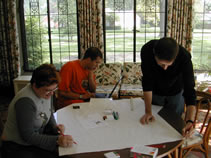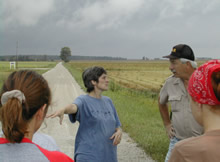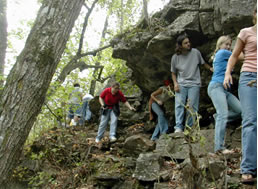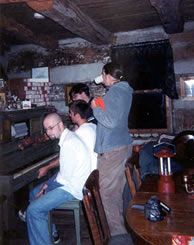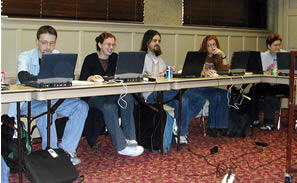 |
 |
 |
 |
 |
||
|
|||||||||
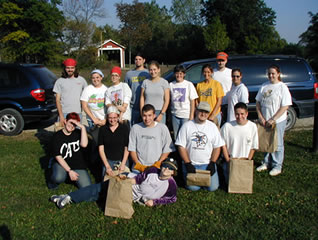 Our
Story Our
Story
Our semester at the Virginia Ball Center was far more eventful than a semester of normal classes. We camped, we hiked, we dug holes, we used computers until we were nearly blind. We found out how much work is really involved in creating an educational website. The first task we had to accomplish was to learn about the land of Indiana, what kinds of ecosystems exist here, and what the major pollution problems are in the state. We also had to discuss what constituted a “Hoosier writer” and the difference between an environmental and a natural history writer. Many guests were invited by Dr. Stedman, the Center and the university to speak to us about these various topics. Among these speakers were well-known and award-winning authors such as Ann Zwinger, a native Indiana naturalist; Scott Russell Sanders, a Bloomington nature writer; David Wagoner, an acclaimed poet who has lived in northwestern Indiana; and N. Scott Momaday, a Native American writer.
We began to research authors individually, searching for biographical information and connections to Indiana’s environment in their works, a task that sounds simpler than it truly was. Many of the authors wrote prior to 1900 and even finding their date of birth was a challenge, let alone finding all of their writings. At the same time, we began learning to use computer software to create and design webpages. Very few of us had any experience with this area of the work, so it became a long and grueling process to teach everyone how to operate the programs correctly. Many thanks are due to Clint Winkler, a BSU landscape architecture graduate student, for his time and patience. His opinions helped guide us in the right direction.
On a 4.37-acre plot of land near Geneva, Indiana, we began the work of restoring farm field to its original state of wetlands. We worked on this and other sections of the Limberlost throughout the semester in addition to our other work. The restoration was quite difficult at times, particularly in severe, monsoon-like thunderstorms. We were assisted by the very capable Mr. Ken Brunswick, Wetlands Manager for the Limberlost State Historic Site, which is run by the Indiana Department of Natural Resources. Dr. Stedman planned two camping trips, one to west central and southwest Indiana and one to the northwest, with the intent of better acquainting us with the landscapes of our state. Our first trip was three days long, beginning bright and early one Friday morning in mid-September with lots of coffee and bagels and even more grumbling. The complaining ended, for the most part, when the canoe trip down Sugar Creek in west central Indiana began. We enjoyed beautiful weather, even if the water levels in the creek were a bit low. The lodging that night was less than rustic, but still a bit farther from cities than the majority of us were used to being. The proprietor of the campground was kind enough to take us on a hayride through the grounds and show us all the campsite had to offer. A few brave souls attempted to sleep outdoors, but a sudden rain shower at midnight sent them indoors searching for floor space.
The next morning began painfully early once again with a trip to Bloomington, where we met with noted naturalist writer Scott Russell Sanders. He showed us different sections of Bloomington that had been built with local limestone, like the restored Showers factory building and Courthouse square. After touring Bloomington, Sanders led us on a hike through Cedar Bluffs, the Nature Conservancy area that is the subject of his essay “Sanctuary.” It was a somewhat strenuous trip at times, and many of us found that we were not in as good a shape as we had previously imagined. The last two places we visited with Sanders were an old cemetery with many limestone grave markers and the quarry from which the limestone used to construct the Empire State Building was taken. The limestone quarries were grander than one might imagine, with deep, blue-green water at the bottom. After we left Sanders, we hiked over Hemlock Cliffs, then headed south to Patoka Lake where we stayed the night. The women’s lodging for the second night was nicer than many of the houses most of us rent at college. There were plenty of beds for all, and a even a television that Dr. Stedman quickly outlawed. Meanwhile, the men received the short end of the stick, with too few beds and little heat. The third day began slightly later than the previous two, but still too early for most. We viewed the Ohio River but not before touring Wyandotte Caves. The small bats that inhabit the caves were oblivious to our cameras and provided most students with their first opportunity to see a bat up close. The majority of the day was spent driving the long route home. By the end of the trip, we knew one another frighteningly well and had lost count of the number of U-turns we had to make. The second trip, which was to northwest Indiana, was only two days, but just as packed with interesting happenings and U-turns. It began at a much more reasonable time on a Saturday in October with a drive to the Jasper-Pulaski Fish and Wildlife Area to see the migration of the sandhill cranes, which are migratory birds that thrive in the wetlands. The weather was significantly colder than it had been on our previous trip, but the birds did not seem to notice. The cranes presented us with a magnificent spectacle as thousands of them landed in the grassy field and danced among the deer that were grazing. Not long after sunset, the flock of 11,000 or more birds took off in large groups for a nearby marsh.
After viewing the cranes, we returned to our 1830s-style log cabins to warm up with caramel apples and hot chocolate. The men entertained us all with the pedal-pumped player piano and their vocal renditions of songs ranging from Stevie Wonder to numbers from Oklahoma until one in the morning, when they returned to their primitive cabin. The next morning was spent hiking over mountainous sand dunes at the National Lakeshore on Lake Michigan, and then emptying the dunes out of our shoes and socks. We walked the Cowles Bog trail as well, and encountered wildlife along the way, mostly in the form of a couple of class members reenacting the dance of the sandhill cranes. The afternoon was spent on a quick drive through Gary to see the steel mills, oil refineries and the Calumet River, before our return to Muncie.
The camping trips and Limberlost work provided a nice contrast to the normal day-to-day activities of researching, writing and slaving over keyboards. Most of the semester was spent indoors, cursing computers and technology in general while we created appropriate layouts for pages, chose pictures and wrote and edited texts. The class divided into three teams in order to distribute the workload evenly. The research team handled any research that was not directly related to an author entry, such as the environment sections. They also wrote texts for other portions of the site and compiled large lists of information. The design team handled all of the images and aesthetic work for the site, such as the color palette and the banner design. The development team worked to create all of the pages and place the texts and designs into them. There were also students who used this seminar as a springboard for their Honors College senior theses. These individual projects were of the students’ creation and done entirely on their own. The seminar provided a very memorable and valuable experience for all of us. Not only were we able to learn more about Indiana’s environment and the literature, we were given the opportunity to help restore a small piece of the Limberlost and make lasting friendships with fellow students in the seminar. The experience was a rewarding one, and one we will continue to hold dear for years to come. --AKS |
|
||||||||||||||||||||



